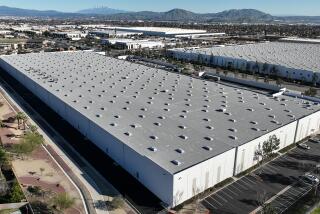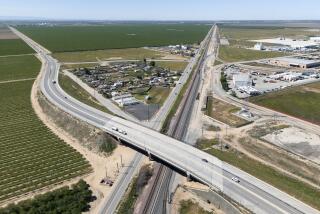What would happen if Amazon brought 50,000 workers to your city? Ask Seattle
Reporting from seattle — Amazon.com has driven an economic boom in Seattle, bestowing more than 40,000 jobs upon a city known for Starbucks coffee and Seahawks fandom. Its growth remade a neglected industrial swath north of downtown into a hub of young workers and fixed the region, along with Microsoft before it, as a premier locale for the Internet economy outside Silicon Valley.
Seattle is the fastest-growing big city in the United States, a company town with construction cranes busily erecting new apartments for newly arriving tech workers. Google and Facebook have joined Amazon in putting large offices there.
When Amazon made a surprise announcement last month that it planned to open a second headquarters with even more jobs, it set off an unprecedented race among cities to lure the tech giant their way. Amazon said it will need 8 million square feet in a second region, making it the biggest economic development target in decades, experts say. Bids were to be submitted by Oct. 19.
But as Seattleites will say, keeping up with the Internet juggernaut has not always been easy, providing a word of caution for officials from other cities willing to pursue the company at great expense.
Over the past decade, Amazon and founder Jeff Bezos, who owns the Washington Post, have added new products and business units at a breakneck speed and expected public partners to keep pace.
In Seattle, that meant rehabbing an area of more than 350 acres at a cost to taxpayers of hundreds of millions of dollars in ongoing transportation and infrastructure upgrades as well as expanding public transit, road networks, parks and utilities.
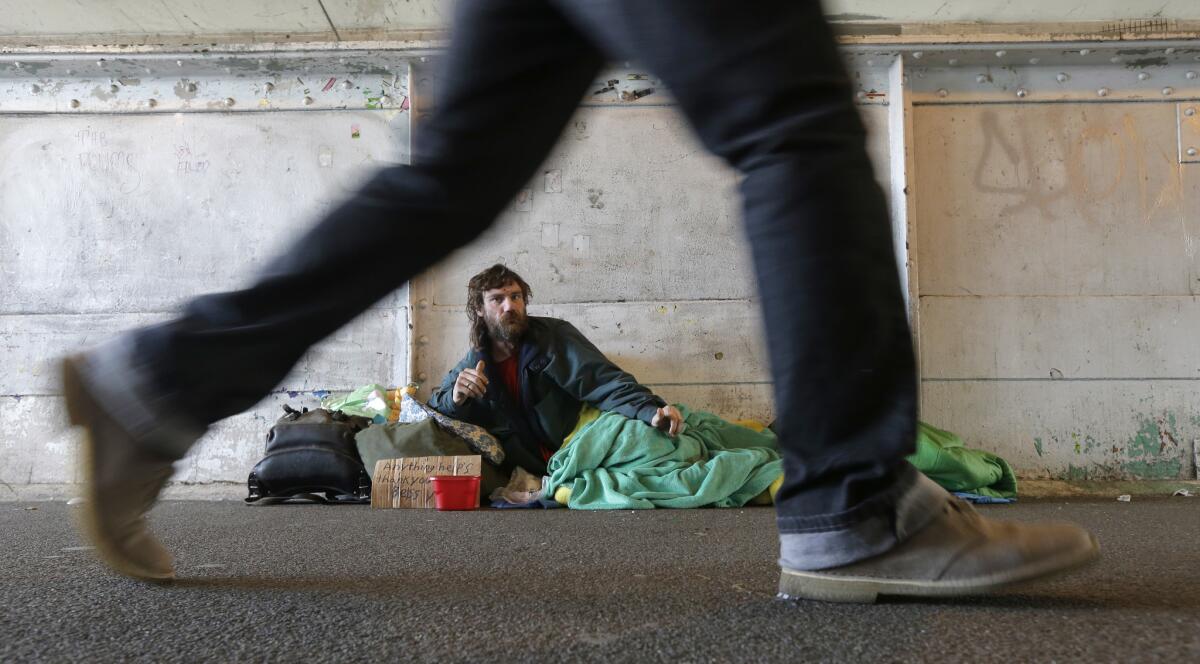
It also put new strains on housing. Seattle is one of the most expensive places in the United States to live, forcing lower-income residents to move to far-off suburbs. The city and surrounding King County declared a state of emergency in 2015 over homelessness.
Since then, the problem has worsened. Rents in King County have more than doubled in the past 20 years and gone up 65% since 2009. Seattle spends more than $60 million annually to address homelessness, up from $39 million four years ago.
“We started seeing apartment listings that would say, ‘No deposit needed and priority for Amazon, Microsoft and Google employees,’ ” said Rachael Myers, executive director of the Washington Low Income Housing Alliance, a Seattle-based advocacy group.
How much of Seattle’s evolution is attributable to Amazon is a matter of debate. In the past decade, millennial workers have poured into other big cities — Washington, San Francisco, Boston — exacerbating housing costs and homelessness there.
But few buildups are so linked to the prospects of one company. Amazon has contributed $30 billion to the local economy and as much as $55 billion more in spinoff benefits. Unemployment in the Seattle area is 3.7%, below the national rate of 4.4%.
Much of that progress is the result of Amazon’s decision to open its first headquarters downtown a decade ago. John Schoettler, who oversees real estate for the online giant, thought it simplest and least expensive to plan a suburban headquarters campus east of Lake Washington in Bellevue, Wash., near Microsoft.
Bezos had a different idea. He wanted to stay in Seattle.
“Jeff said the type of employees we want to hire and retain will want to live in an urban environment. They are going to want to work, live and play in the urban core,” Schoettler said.
The decision helped usher in a new era, one in which top employers abandon suburban office parks for lively, urban neighborhoods integrated into the cities around them. Only seven Fortune 500 companies had research or engineering hubs in Seattle in 2010; now 31 do.
“Their growth has just been so positive to lots of other companies, big and small and medium and in between,” said Jon Scholes, president and chief executive of the Downtown Seattle Assn., where Schoettler is a board member.
It’s a boom that has shown little sign of slowing. Seattle added 57 people a day for a year through the summer of 2016, according to census data. How best to accommodate that growth provokes regular debate in Seattle and could well shape whatever city Amazon comes to next.
Such details spark little discussion as mayors and governors from coast to coast have embarked upon a sweepstakes fit for a reality show, touting their cities in online videos and dangling taxpayer-funded subsidies of as much as $7 billion, even if their jurisdictions don’t have the workforce or transportation network Amazon said it requires.
Amy Liu of the Brookings Institution said the Amazon competition will hopefully serve as a chance for elected leaders to take the temperature of how prepared their neighborhoods and infrastructure are to drive growth, whether from Amazon or elsewhere.
Seattle won its economic beauty contest in 1962, when it hosted the World’s Fair. To serve the crowds, the city built acres of parking and low-slung motels in an area known as South Lake Union.
The bet paid few dividends. Three decades later, the area was probably best known for a printing plant, struggling motels and a Hooters restaurant. Only 677 people lived there in 1990.
Then Paul Allen, co-founder of Microsoft, launched a real estate firm called Vulcan and bought 60 acres in the area. Vulcan executive Ada Healey recalls the early skeptics. During a 2002 pitch meeting, she said, a representative from a prospective company turned to her and asked: “Why would I want to move to South Lake Union? It is a wasteland.”
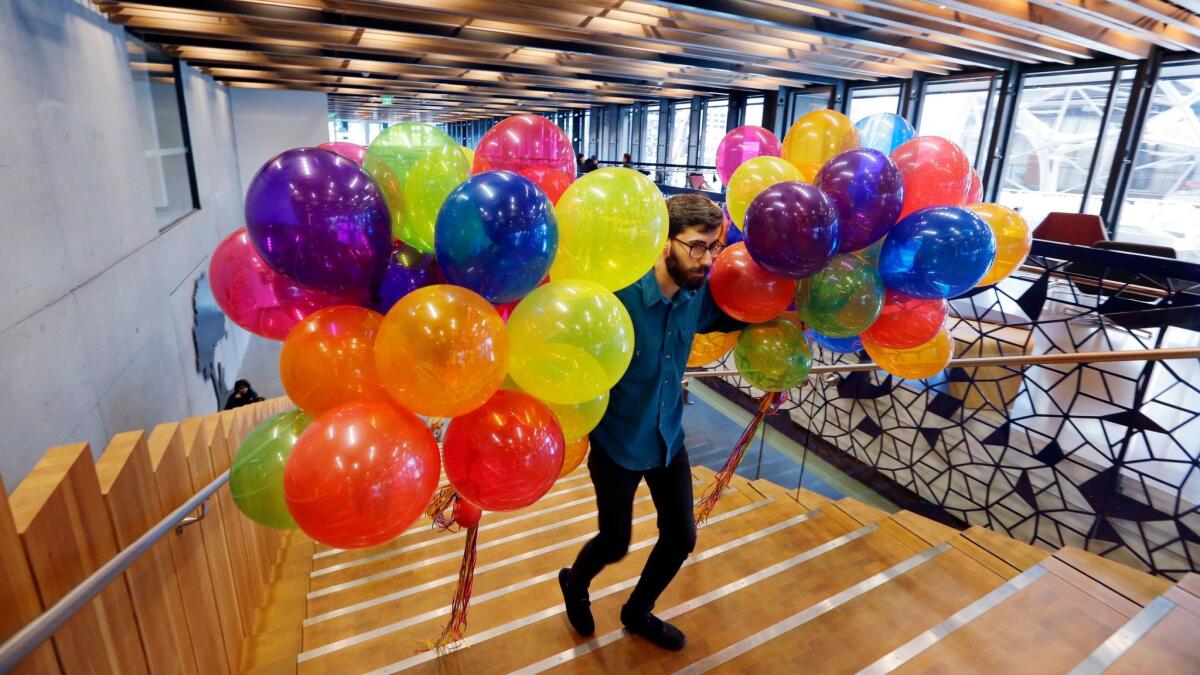
Bezos, though, saw promise in the urban locale. He had started Amazon in his garage in nearby Bellevue, then opened an early office in a former military hospital now called Pacific Tower. Before long, he was searching for more space to accommodate his fast-growing company.
Schoettler initially secured about 1.7 million square feet in 10 buildings. It was enough, he thought, to contain the company through 2016, when it was projected to have 9,300 employees.
Instead, Amazon grew five times as fast. It now has more than 40,000 employees in 33 Seattle buildings totaling 8.1 million square feet. It occupies 19% of the high-end office space in the city, according to an analysis by the Seattle Times, as many square feet as the city’s next 40 biggest employers combined.
Next year, Amazon will complete its most prominent addition — three glass biospheres featuring about 40,000 plants, “a unique environment for employees to come and collaborate and innovate,” Schoettler said.
Seattle officials have raced to keep up, approving $480.5 million in improvements over more than a decade for South Lake Union. Amazon and Vulcan, in need of approval to take over city alleys for its development, chipped in funding.
A $190.5-million road-realignment program included $31.4 million from property owners led by Vulcan. A new, 1.3-mile streetcar line cost $56.4 million and benefited from $5.5 million from Amazon, including the donation of a fourth car. Now the city has embarked on a $201.5-million electrical substation, work that includes burying electrical wires.
On weekdays, South Lake Union teems with young workers sporting Amazon name tags and eating bananas that the company offers free to passersby. Many are walking their dogs — 4,000 employee-owned pups are registered with headquarters access, helping Seattle earn notoriety recently for having more dogs than children.
The campus has produced spillover benefits for the city. Amazon’s buildings are home to 34 restaurants, including a culinary job-training program called FareStart. More than 20% of employees walk to work, and fewer than half drive.
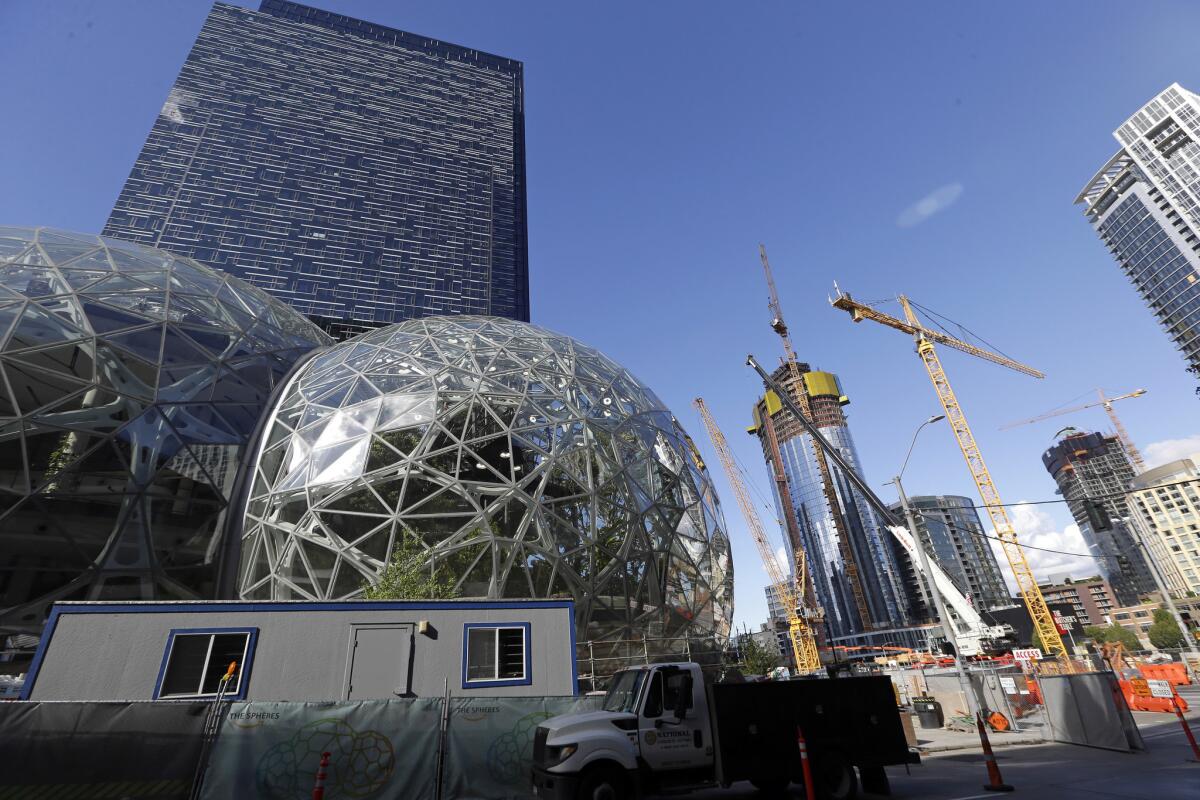
The company’s longtime support for lesbian, gay, bisexual and transgender rights — including a $2.5 million donation that Bezos and his wife, MacKenzie, made in support of same-sex marriage — dovetail with the city’s progressive politics.
“We could have gone to the suburbs, and we could have built a campus, and we would have had an entry gate where everybody would come and go so you would be very inward-looking and very exclusive,” Schoettler said, “as opposed to being in a very urban environment where you have to look outward, so you’re very inclusive, and everyone is your neighbor — and everyone is welcome.”
Maybe no city could have built housing fast enough to keep prices from spiraling upward during Amazon’s growth, but Seattle — despite nearly leading the nation in new apartment construction — hasn’t come close.
On the sidewalks, alongside rentable neon bikes, people subsist in tents and sleeping bags in places locals say they did not congregate at 10 years ago — a warning sign for cities nationwide trying to capture a version of Seattle’s glory.
“We don’t have enough housing for low-income people especially, but we also just don’t have enough housing,” said Myers, a longtime Seattle housing advocate. “And Amazon obviously impacts both of those things.”
Officials at Bellwether Housing, the city’s largest nonprofit manager of affordable housing, at 2,000 units, report a vacancy rate of 1%. “It’s very rare that someone moves out, because they have nowhere else to go,” said chief executive Susan Boyd.
A state analysis of evictions found they were driven not by social problems but by economics. As Amazon’s boom has continued, the city approved a rule this year requiring landlords to accept the first viable renter who applies — rather than cherry-picking a tech worker.
The government also adopted an inclusionary zoning policy requiring developers to set aside some new units at below-market rates or pay into a fund to develop other affordable units.
Myers suggested other jurisdictions pay heed: “If you’re going to get an Amazon that’s going to create a ton of high-paying jobs and a ton of pressure on the housing market, what are the things you can do before rents really skyrocket?”
“These are things every city should be doing anyway,” she said.
ALSO
Tesla reportedly reaches agreement to build car factory in Shanghai
UCLA’s effort to patent a costly prostate cancer drug in India hurts the poor, critics say
Bill O’Reilly reportedly paid $32-million harassment settlement before signing new Fox News contract
More to Read
Inside the business of entertainment
The Wide Shot brings you news, analysis and insights on everything from streaming wars to production — and what it all means for the future.
You may occasionally receive promotional content from the Los Angeles Times.
